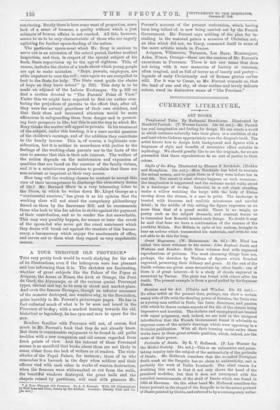A TOUR THROUGH OLD PROVENCE.*
Vas very pretty book would be worth studying for the sake of its illustrations, even if the letterpress were less pleasant and less informing than it is. The sketches are fascinating, whether of great subjects like the Palace of the Popes at Avignon, the Arena at Nimes, the Arch at Orange, the Pont du Gard, the Alyseamps, or of the various quaint Provençal types, clerical and lay, to be seen in street and market-place. And even the famous Tarasque, though an inferior successor of the monster destroyed, one wonders why, in the Revolution, grins horribly in Mr. Forrest's picturesque pages. He has in fact collected much of what is to be seen and beard in the Provence of to-day ; with a marked leaning towards the old, historical or legendary, be has eyes and ears to spare for the
Readers familiar with Provence will not, of course, find much in Mr. Forrest's book that they do not already know. But there is considerable enjoyment to be found in old paths trodden with a new companion and old scenes regarded from fresh points of view. And the interest of these Provençal scenes is so manifold that books about them are not likely to cease, either from the lack of writers or of readers. The vicis- situdes of the Papal Palace, for instance ; those of us who remember it a barrack in the days when soldiers and their officers vied with each other in works of wanton destruction, when the frescoes were whitewashed or cut from the walls, the beautiful windows destroyed, the great halls and the chapels ruined by partitions, will read with pleasure Mr.
• A Tour Through Oki Broome.% By A. S. Forrest. With 108 Illustrations In Halt-tone and Line, drawn by the Author. London: Stanley Paul and Co.
Os. net.] Forrest's account of the present restoration, which, having been long talked of, is now being carried out by the French Government. Mr. Forrest says nothing of the plan for in. stalling in the restored palace a museum of Christian art; an idea which did not, we fancy, commend itself to some of the more artistic minds in France.
Avignon, Villeneuve, Tarasoon, Les Baux, Montmajour, Arles, Nimes, Orange—these are the centres of Mr. Forrest's excursions in Provence. There is not one name that does not bring with it rare memories of history or romance, often tragical, and as full of terror as of beauty and poetry— legends of early Christianity and of Roman glories earlier still. For it was to Caesar, as Mr. Forrest reminds us, that the land of sun and sky, of clear outline and lovely delicate colour, owed its distinctive name of "The Province."






















































 Previous page
Previous page